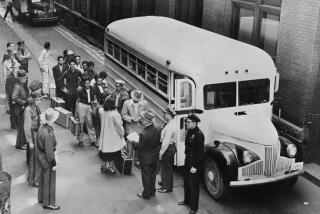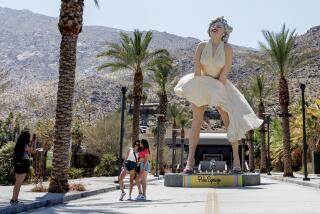Healthy Move for Famous Statue at Cabrillo Monument
- Share via
SAN DIEGO — Juan Rodriguez Cabrillo is going the way of all flesh, a victim of salt crystallization, “visitor abuse” and maybe the fallout from a few thousand jet plane engines.
A chunk of his tunic has chipped off. His aquiline nose is cracked across the bridge. Now an old injury--a torso break--is acting up.
So the seven-ton statue is being retired after 37 years of surveying San Diego Bay from Cabrillo National Monument at Point Loma. The National Park Service figures that 40 million people have admired the figure, commemorating the first European to discover what is now California.
The service plans to move the sculpture inside the museum at Point Loma. There, the chief conservator for the Park Service eventually will go to work with poultices and resins, patching up Cabrillo’s aching constitution.
Meanwhile, in Portugal, sculptor Charters Almeida expects to finish a replica of the statue by late next February, said Doris Omundson, superintendent of Cabrillo National Monument. Carved from a more-durable type of limestone, it will be brought to Point Loma to take the place of the original statue.
“It was with a great deal of reluctance that any decision was made to move the piece indoors,” said Gregory Byrne, chief conservator for the Park Service in Harpers Ferry, W. Va. “But the conclusion of many experts was that, if it continued to remain outside, we would lose it.”
The statue’s problems stem from the soft, porous limestone from which it was carved in Portugal in the late 1930s. A gift from Portugal to California, the sculpture broke in half before it reached the West Coast, and has been deteriorating ever since.
First, it has been damaged by briny ocean air at the monument, one of the most popular national monuments after the Statue of Liberty. Moist air penetrates the stone and dissolved salts crystallize inside, expanding and slowly chipping off layers of stone.
The statue also suffers from what Byrne called “visitor abuse”--tourists mauling it, climbing on it, and pocketing loose bits. Many of the broken chunks have been saved by the Park Service and will be put back on during the restoration.
Finally, it appears to have been eroded by acid rain, Byrne said. He speculated that the damage may have been done by sulfuric acid--a product of hydrocarbon combustion in the engines of the jet planes from nearby North Island Naval Air Station.
The statue, 12 feet tall, was carved in the late 1930s by Portuguese sculptor Alvaro de Bree in commemoration of Cabrillo’s arrival in San Diego Bay in 1542. The Portuguese explorer sailed under the Spanish flag, and died a few months after completing the journey.
The statue was shipped west for an exposition in San Francisco in 1940 but never went on display. Instead, it ended up in a garage after the exposition committee turned it over to the state in order to avoid paying customs duties.
It was discovered there by Lawrence Oliver of San Diego, who with the help of then-state Sen. Ed Fletcher brought the statue to San Diego. It was initially placed on the bay at water level, then moved up to Point Loma during World War II to clear space for use by the Navy.
More to Read
Sign up for The Wild
We’ll help you find the best places to hike, bike and run, as well as the perfect silent spots for meditation and yoga.
You may occasionally receive promotional content from the Los Angeles Times.






